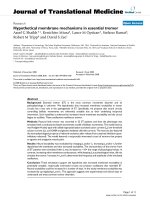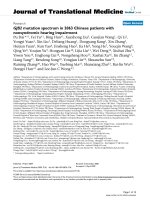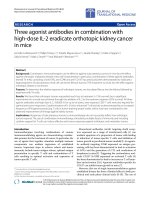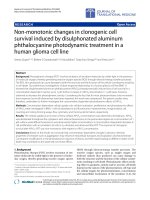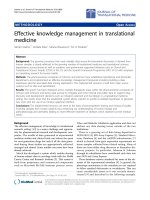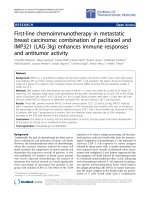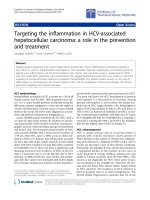báo cáo hóa học:" Social anxiety disorder in genuine halitosis patients" potx
Bạn đang xem bản rút gọn của tài liệu. Xem và tải ngay bản đầy đủ của tài liệu tại đây (214.74 KB, 7 trang )
RESEARCH Open Access
Social anxiety disorder in genuine halitosis
patients
Takashi Zaitsu
1*
, Masayuki Ueno
1
, Kayoko Shinada
2
, Fredrick A Wright
3
and Yoko Kawaguchi
1
Abstract
Background: There is a possibility that genuine halitosis patients’ anxiety do not recover after oral malodor
treatment due to their social anxiety disorder. The objective of this study was to investigate the influence of social
anxiety disorder on the level of anxiety in genuine halitosis patients before and after treatment for oral malodor.
Methods: The subjects were 262 genuine halitosis patients who visited the Fresh Breath Clinic from March, 2008
to October, 2009. The subjects who had score 2 or higher by the organoleptic test were diagnosed as genuine
halitosis patients. Gas chromatography (GC) was conducted before and after oral malodor treatment for the oral
malodor measurement. Based on their risk of social anxiety disorder, subjects were divided into low- and high-risk
groups using the Liebowitz Social Anxiety Scale (LSAS). The questions related to oral malodor and the clinical oral
examination were both conducted before oral malodor treatment. The level of anxiety before and after oral
malodor treatment was evaluated using the Visual Analogue Scale of Anxiety (VAAS).
Results: More than 20% of subjects had a score of 60 or more on the LSAS (high LSAS group). The mean age and
the percentage of females were significantly higher in the high LSAS group compared to the low LSAS group. The
high LSAS group was more likely to have problems associated with oral malodor and to adopt measures against
oral malodor compared to the low LSAS group. The mean concentrations of H
2
S and CH
3
SH by GC significantly
decreased after the oral malodor treatment in both LSAS groups. VAAS scores also significantly decreased after
treatment in both LSAS groups. The logistic regression analysis indicated that the high LSAS group had a 2.28
times higher risk of having a post-VAAS score of 50 or more compared to the low LSAS group.
Conclusions: This study revealed that genuine halitosis patients with a strong trait of social anxiety disorder have
difficulty overcoming their anxiety about oral malodor. Oral malodor treatment of genuine halitos is patients
requires not only regular oral malodor treatment but also attention to social anxiety disorder.
Background
Several studies reveal that soc ial anxiety disorder is the
most common anxiety disorder. It usually has an early
onset, and has serious effects on social interactions and
qua lity of l ife [1,2]. The Diagnostic and Statistical Man-
ual, Fourth Edition (DSM-IV) of the American Psychia-
tric Association defines social anxiety disorder as a
persistent fear in one or more social or performance
situations whenever the person is exposed to unfamiliar
people or to possible scrutiny by others [3]. In the Uni-
ted States, social anxiety disorder has the third highest
prevalence among psychological diseases after
depression and alcohol dependence [4]. Excessive anxi-
ety in social situations causes considerable distress and
impairs carrying out daily activities [5].
Previous research revealed that pseudohalitosis
patients have higher scores on some items of the Lie-
bowitz Social Anxiety Scale (LSAS), a questionnaire to
evaluate the social anxiety disorder, than genuine halito-
sis patients [6]. Moreover, generalized social anxiety dis-
order was observed in 19.5% of genuine halitosis
patients, and 27.9% of the pseudohalitosis patients, for a
combined 21.8% of all halitosis patients. These findings
suggest that there is a relationship between the type of
patient with oral malodor and social anxiety disorder.
According t o the classification of h alitosis by Yaegaki
et al., genuine halitosis is defined as “ obvious malodor
with intensity beyond a socially acceptable level is
* Correspondence:
1
Department of Oral Health Promotion, Graduate School of Medical and
Dental Sciences, Tokyo Medical and Dental University, Japan
Full list of author information is available at the end of the article
Zaitsu et al. Health and Quality of Life Outcomes 2011, 9:94
/>© 2011 Zaitsu et al; licensee BioMed Central Ltd. This is an Open Access article distributed under the terms of the Creative Commons
Attribution License (htt p://creativecommons.org/licenses/by/2.0), which permits unrestricted use, dis tribution, and reproduction in
any medium, provided the original work is properly cited.
perceived”, and pseudohalitosis is defined as “obvious
malodor is not perceived by others, although the patient
stubbornly complains of its existence. [7,8]“ Some
research indicates that pseudohalitosis patients have a
stronger tendency for depression compared with genu-
ine halitosis patients [9,10]. It has also been suggested
that pseudohalitosis is r elated to both their somatic and
emotional status, and that psychological disorders are
strongly associated with the halitosis classification. Thus,
pseudohalitosis patients receive instruction, education
and counseling as part of their treatment [11].
However, the counseling procedure for genuine halito-
sis patients has not been examined thoroughly. It is
often the case that the treatment of the genuine halitosis
patient ends when regular oral malodor treatment ends.
Because their mental aspect is not fully addressed, some
genuine halitosis patients do not improve their anxiety
level and QOL despite ameli oration of their oral malo-
dor. Some research suggests that, like pseudohalitosis
patients, genuine halitosis patients may also have asso-
ciated psychological problems, such as social anxiety dis-
order [7,12], that may be overlooked. The hypothesis in
thisstudyisthatsomegenuine halitosis patients may
have social anxiety disorder that hinders their recovery
from oral malodor related an xiety. If a relationship
between social anxiety disorder and the worry or uneasi-
ness of oral malodor patients is established, the neces-
sity for oral malodor treatment to take social anxiety
disorder into consideration will be clarified.
Therefore, the purposes of this study were to examine
the influence of social anxiety disorder on oral malodor-
related anxiety before and after the treatment of the oral
malodor.
Methods
Study subjects
Patients who visited or were referred to the Fresh Breath
Clinic at the Dental Hospital of Tokyo Medical and
Dental University between March, 2008 and October,
2009 were invited to join the study. After being told the
nature of the research, two hundred and sixty-two
patients (83 males and 179 females, mean age: 51.9 ±
14.3 years, age range 16-8 3 years), diagnosed with genu-
ine halitosis, signed the informed consent form and par-
ticipated in the study. The study protocol was approved
by the Tokyo Medical and Dental University Ethics
Committee.
Study Instruments
A self-administered questionnaire w as administered to
all subjects at the initial visit. The questionnaire con-
sisted of 1) Questions related to ora l malodor, 2) The
Liebowitz Social Anxiety Scale (LSAS) [13] and 3) The
Visual Analogue Scale of A nxiety (VAAS) [14,15].
Following the questionnaire, oral malodor and oral
health status were assessed. Oral malodor was measured
by specialist dentists at the clinic. The oral malodor
treatment was based on the Treatment Need (TN) by
classification of Halitosis by Yaegaki et al. [7,11,16].
After the completion of treatment for oral malodor, we
conducted the VAAS again.
1. Questionnaire
(1) Questions related to oral malodor
The following five questions consisted of: 1) “How did
you first notice your bad breath?”,2)“What do you see
as the problem with your having bad breath?”,3)“Is
there anything you do to decrease your bad breath?”,4)
“ Are you anxious about others’ smells?” ,5)“Are you
sensitive to the smell?”,and6)” Are you anxious about
body odor?”
(2) Liebowitz Social Anxiety Scale (LSAS)
The LSAS contains 24 situational questions (13 per-
formance and 11 social interaction items), to which sub-
jects respond on a 4-point scale for both fear/anxiety
and avoidance sections [13,17]. The scale range of fear/
anxiety was from 0 to 3 (0 = none, 1 = mild, 2 = moder-
ate, and 3 = severe) and avoidance was from 0 to 3 (0 =
never, 1 = occasionally, 2 = often, and 3 = usually).
Total fear/anxiety and total avoidance scores are both 0-
72, and thus, the total LSAS score falls between 0-144.
The Japanese version of the scale (LSAS-J) was used in
this study [18]. The cutoff value of the LSAS to diagnose
generalized social anxiety disorder is 60 [19,20]. There-
fore, we placed subjects with a total LSAS score of 60
or higher in the high LSAS group and s ubjects with a
total LSAS score of 59 or lower in the low LSAS group.
(3) Visual Analogue Scale of Anxiety (VAAS)
The VAAS was conducted to evaluate patients’ anxiety
before treatment (pre-VAAS) and after treatment (post-
VAAS). The VAAS is a 10 cm-long horizontal line, in
which s ubjects mark t heir anxiety level with a ballpoint
pen.Theminimumscoreis0whichmeans“ no anxiety
at all” and the maximum is 100 representing “ worst
anxiety imaginable [21].” We placed subjects with VAAS
scores of less than 50 in the “low VAAS group” ,and
thosewithscoresof50ormoreinthe“high VAAS
group”.
2. Oral malodor assessment
We conducted two methods, the Organoleptic test (OT)
and Gas chromatography (GC) for the oral malodor
measurement. Measurements were conducted between 9
and 11 o’clock in the morning bec ause morning brea th
odor has been used as a standard mouth breath for oral
malodor [22]. We advised patient s not to have food or
drink, and to refrain from their usual oral hygiene prac-
tice on the morning of the oral malodor assessment. To
exclude confounding smells, we instructed patients to
stop eating strong-smelling foods for at least 48 h ours
Zaitsu et al. Health and Quality of Life Outcomes 2011, 9:94
/>Page 2 of 7
before the oral malodor assessment, stop using strong-
scented perfumes for 24 hours, and stop smoking or
drinking alcohol for 12 hours prior to the assessment.
(1) Organoleptic Test (OT)
We used the OT as the clinical measurement of oral
malodor. The OT was conducted after subjects had
closed their mouth for 3 minutes while breathing
through their nose. The OT w as performed by 7 den-
tists, who were calibrated with the T&T Olfactometer
(Daiichi Yakuhin Sangyo Co. Tokyo, Japan), an odor
solution kit for examining the olfactory sense [23,24].
Two judges rated the malodor on a 0-5 scale where a
score of 0 = absence of odor, 1 = barely appreciable
odor, 2 = slight malodor, 3 = moderate malodor, 4 =
strong malodor, and 5 = severe malodor [25-27]. If the
judges gave different scores, the mean score represented
the score for the subject. Subjects who were scored 2 or
higher by the OT were diagnosed as having genuine
halitosis.
(2) Gas chromatography (GC)
A GC-8A gas chromatograph (Shimadzu, Kyoto, Japan)
equipped with a flame photometric detector was used for
the GC analysis. It has an auto-injection system with a 10
ml Teflon (Du Pont, Tokyo, Japan) sample loop and a col-
umn packed with 25% 1, 2, 3-tris (2-cyanoethoxy) propane
on an 80/100 mesh Shimalite AW-DMCS-ST support sys-
tem at 60°C. The Teflon tube was directly inserted into
the oral cavity of a patient through the lips and teeth for
the malodor measurement, and 20 mL of mouth air was
aspirated with a syringe connected to the outlet of the
auto-injector. Following the aspiration, a 10 mL sample of
air was transferred to the column and chromatographed
by a sulfur chemiluminescence detector that specifically
responded to sulfur. The volatile sulfur compounds
(VSCs) gases, H
2
S and CH
3
SH, were determined by their
characteristic retention times, and quantities were cal cu-
lated by comparing their peak areas with those of dilutions
of standard gases of H
2
SandCH
3
SH that were prepar ed
with a PD-1B permeater (Gastec Company, Kanagawa,
Japan). Outcomes were shown as concentrations of H
2
S
and CH
3
SH (ng/10 mL). Based on the olfactory threshold
levels (H
2
S > 1.5 ng/10 mL and CH
3
SH > 0.5 ng/10 mL)
proposed by Tonzetich [28], patients were classified as
either normal or having malodor.
3. Oral health status
The clinical oral examination included an as sessment of
the number of teeth present, number of decayed teeth,
periodontal pocket depth (PPD), bleeding on probing
(BOP), oral hygiene and volume of resting saliva.
Standardized clinical criteria were based on the W.H.O.
format [29]. We examined the PPD using a dental mirror
and a periodontal probe. The deepest PPD was recorded
by probing circumferentially around the tooth. The aver-
age value of PPD of all teeth was used as the representative
value for the person. We checked presence of BOP on
each tooth while measuring the PPDs. Oral hygiene was
evaluatedusingtheSilness-Löeplaqueindex(PI)onsix
index teeth [30]. The score ranged from 0 to 3 where a
score of 0 = no plaque, a score of 1 = a film of plaque
adhering to the free gingival margin and adjacent area of
the tooth with the plaque visible when using the probe on
the tooth surface, a score of 2 = moderate accumulation of
soft deposits within the gingival pocket, or the tooth and
gingival margin that could be seen with the naked eye, and
a score of 3 = abundance of soft matter within the gingival
pocket or on the tooth and gingival margin. The average
value of all tooth surfaces was recorded as the plaque
index score.
We collected resting saliva by letting subjects spit
pooled saliva into a cup for 5 m inutes. The resting sali-
vary flow rate was calculated as amount per minute
(mL/min).
Statistical analysis
Student t-tests and Chi-squared tests were used to com-
pare the m eans or dist ributional differences of age, gen-
der, oral health status, questions related to oral malodor
and VAAS between the low LSAS and high LSAS
groups. Paired t-tests were conducted to det ect differ-
ences of mean concentrations of VSC gases and VAAS
scores before and after treatment. Values of oral health
status were recorded for multivariate statistical analysis.
We categorized patients as having either 19 or fewer
teeth present or 20 or more teeth present, and sepa-
rately categorized as having either 0 decayed teeth or 1
or more decayed teeth. For PPD, BOP, and PI, patients
were categorized into low and high groups by the med-
ian. For salivary flow rate, patients were categorized as
having less than 0.1 mL/min and 0.1 mL/min or more.
The concentrations of H
2
SandCH
3
SH were dichoto-
mized using the threshold levels.
ANCOVA was performed with the post-VAAS score
as the dependent variable, and the two LSAS groups as
independent variables afteradjustingforage,gender,
pre-VAAS score and the concentration of VSC gases
after the treatment. We conducted logistic regression
analysis with the post-VAAS score as the dependent
variable, and age, gender, LSAS, oral health status, pre-
VAAS score, and the conc entration of VSC gases after
treatment as independent variables.
All tests were conducted at the 5% significance level.
SPSS statistical software package was used for all ana-
lyses (SPSS 18.0J; SPSS Japan, Tokyo, Japan).
Results
Characteristics of the two LSAS groups
The mean LSAS score was 38.9 ± 28.3. The proportion
of subjects in the high LSAS group was 22.9% (N = 60),
Zaitsu et al. Health and Quality of Life Outcomes 2011, 9:94
/>Page 3 of 7
and in the low LSAS group was 77.1% (N = 202). The
mean age and the percentage of females were signifi-
cantly higher in the high LSAS group (55.5 ± 14.5,
85.0%, respectively) compared to the low LSAS group
(50.8 ± 14.0, 63.4%, respectively) (P = 0.031, P = 0.001,
respectively).
Oral malodor
The mean concentrations of H
2
S before the oral malo-
dor treatment were 6.44 ± 5.29 in the low LSAS group
and 6.98 ± 5.39 in the high LSAS group, and after treat-
ment the concentrations were 0.54 ± 0.81 in the low
LSAS group and 0.42 ± 0.79 in the high LSAS group.
Both groups had significantly decreased concentrations
of H
2
S after treatment (P < 0.001). The mean concentra-
tions of CH
3
SH before the oral malodor treatment were
2.31 ± 2.21 in the low LSAS group and 2.37 ± 2.18 in
high LSAS group, and after the treatment the concen-
trations were 0.17 ± 0.26 in the low LSAS group and
0.11±0.23inthethehighLSASgroup.Bothgroups
had significantly decreased concentrations of CH
3
SH
after treatment (P < 0.001).
Oral health status
As shown in Table 1 the high LSAS group had a signifi-
cant ly lower number of teeth present and a significantly
lower plaque index score compared with the low LSAS
group. There were no significant differences in the num-
ber of decayed teeth, PPD, BOP or volume of re sting
saliva between the two groups.
Questions related to oral malodor
There was no significant distributional difference of
responses to the question “How did you first notice your
bad breath?” between the two LSAS groups (Table 2). For
the question “What do you see as the problem with your
having bad breath?” , the percentages of subjects who
answered “Cannot talk with people”, “Cannot act with
people”, “Cannot be active and become negative about
everything”, “Cannot concentrate” or “Cannot make close
friends” were significantly higher in the high LSAS group
compared with the low L SAS group. The percentages of
subjects who answered “Brush teeth many times” and
“Cover my mouth while talking with people” to the ques-
tion “ Is there anything you do to decrease your bad
breath?” were significantly higher in the high LSAS group
than in the low LSAS group. The proportion of subjects
who answered “ yes” to the question “Are you anxious
about body odor?” was significantly higher in the high
LSAS group than in the low LSAS group.
VAAS
Pre-VAAS scores were significantly h igher in the high
LSAS group (72.0 ± 22.5) compared to the low LSAS
group (60.2 ± 28.5; P = 0.001). Post-VAAS scores were
also significantly higher in the high LSAS group (52.0 ±
25.8) compared to the low LSAS group (25.0 ± 20.8; P =
0.005). Moreover, VAAS scores significantly decreased
after treat ment in both groups (P < 0.001). The propor-
tion of subjects with a pre-VAAS score of 50 or higher
was significantly higher in the high LSAS group (88.0%)
compared to the low LSAS group (70.8%; P = 0.006),
and after treatment the proportion was still significantly
higher in the high LSAS group (3 0.0%) compared to the
low LSAS group (15.8%; P = 0.023).
ANCOVA showed that the high LSAS group had a
higher post-VAAS score (30.8 ± 2.7SE) compared to the
low LSAS group (23.2 ± 1.4SE, P = 0.016). The logistic
regression a nalysis showed that the high LSAS group had a
2.28 times higher risk o f having a post-VAAS score of 5 0 or
more compared to the low LSAS group (P = 0.037). More-
over, t he high pre-VAAS group had a 7.09 t imes higher risk
of having a post-VAAS score of 50 or more compared to
the low pre-VAAS group (P = 0 .002) (Table 3).
Discussion
This research indicates that those genuine halitosis
patients with a strong trait of social anxiety disorder
have diffi culty overcoming their anxiety about oral mal-
odor. The relationship between social anxiety disorder
and some other diseases or disorders, such as alcohol
dependency or strabismus, has been investigated [17,31].
Our previous study showed a close relationship between
social anxiety disorder and the classification of halitosis
[6]. However, the cu rrent study is the first to investigate
the relationship between the level of social anxiety dis-
order and th e amount o f improvement of anxiety con-
tingent on oral malodor.
The LSAS is recognized by the International Consen-
sus Group on Depression and Anxiety as the gold stan-
dard for evaluating the clinical impact of social anxiety
disorder in an individual [32]. The LSAS has been trans-
lated into many languages besides English [33,34], and
its reliability and validity have been confirmed. The
Table 1 Clinical characteristics of subjects by LSAS score
LSAS
Low (-59) High (60-)
(N = 202) (N = 60) P value
Mean SD Mean SD
Number of teeth present 26.1 4.0 24.2 5.4 0.014*
Number of decayed teeth 0.4 1.5 0.1 0.5 0.053
PPD (mm) 2.4 0.5 2.5 0.4 0.604
BOP(teeth) 4.3 5.2 4.1 4.1 0.765
Plaque Index 0.5 0.4 0.4 0.3 0.042*
Salivary flow rate (mL/min) 0.3 0.3 0.3 0.3 0.295
* Significant at p < 0.05
Zaitsu et al. Health and Quality of Life Outcomes 2011, 9:94
/>Page 4 of 7
Japanese version of the LSAS also shows high reliability
and verified validity [18]. The VAAS has been used in
several studies to measure the degree of anxiety in b oth
anxiety-disorder and healthy subjects. It has been pro-
ven to be a valid method for the measurement of anxi-
ety and is highly sensitive to changes [14,15].
This study revealed that 22.9% of genuine halitosis
patients had a tendency for general social anxiety disorder.
This percentage is almost the same as the 19.5% reported
in our previous study [6]. The high LSAS group was pre-
dominantly female. According to Turk et al., females tend
to have a higher risk for social anxiety disorder [35]. Social
anxiety disorder is reported to be more likely to develop in
younger people [36,37]. However, in this study the mean
age of subjects in the high LSAS group was higher than
that in the low LSAS. There is the fact that female subjects
who were more dominant in the high LSAS group w ere
older, and it might have influenced the results.
Regarding oral health status, there was a significant
difference in the number of teeth present; the high
LSAS group had less teeth present compared to the low
LSAS group. This also reflects the age difference
between the two LSAS groups, the high LSAS group
being older. The excellent plaque control in the high
LSAS group may be attributed to their high motivation
for brushing to prevent oral malodor.
The high LSAS group was more likely to have problems
associated with oral malodor and to adopt countermea-
sures against oral malodor compared to the low LSAS
group. Moreover, the high LSAS group felt anxious not
only about oral malodor but also about body malodor.
Most halitosis patients greatly improved after receiving
the oral malodor treatment that includes plaque control
instruction, tongue cleaning, and mouth rinses. The con-
centrations of VSCs were also significantly reduced in
both LSAS groups. However, in the short-term, anxiety
remained significantly higher in the high LSAS group even
after the treatment compared with the low LSAS group.
About 30% of the high LSAS group still had a VAAS score
of 50 or higher after treatment, a percentage almost twice
as high as that of the low LSAS group. Moreover, after
controlling for age, gender, oral health status, pre-VAAS,
and the concentration of VSC gases, the presence of social
anxiety disorder greatly influenced the anxiety after the
oral malodor treatment. Thus, social anxiety disorder
should be considered in regular oral malodor treatment.
Table 2 Oral malodor related worries and problems by LSAS score
LSAS
Low (-59) High (60-) P value
(N = 202) (N = 60)
1. How did you first notice your bad breath?(multiple answers)
You noticed it by yourself 24.8% 21.7% 0.732
You have ever been told by others you have bad breath 42.6% 56.7% 0.057
You suspect that you have bad breath based upon
the actions of other persons
67.3% 65.0% 0.716
2. What do you see as the problem in your having bad breath? (multiple answers)
Nothing in particular 14.4% 6.7% 0.127
Cannot talk with people 48.0% 68.3% 0.008*
Cannot act with people 14.4% 46.7% < 0.001*
People avoid me 6.9% 10.0% 0.415
Cannot be active and become negative about everything 37.6% 71.7% < 0.001*
Cannot concentrate 10.4% 23.3% 0.016*
Cannot make close friends 1.5% 11.7% 0.002*
3. Is there anything you do to decrease your bad breath? (multiple answers)
Nothing in particular 5.0% 3.3% 0.739
Brush my teeth many times 66.3% 81.7% 0.025*
Use mouth-rinsing solution/chewing gum/mouth drops 69.8% 68.3% 0.874
Decrease the frequency of meals or snacks 1.0% 5.0% 0.081
Cover my mouth while talking with people 31.7% 48.3% 0.021*
Try to find out the cause of bad breath by visiting many
hospitals and undergoing examinations
13.9% 21.7% 0.158
Clean my tongue 63.9% 65.0% 0.619
4. Are you anxious about others’ smells? 75.7% 66.7% 0.183
5. Are you sensitive to the smell? 59.4% 60.0% > 0.999
6. Are you anxious about the body odor? 59.4% 80.0% 0.003*
* Significant at p < 0.05
Zaitsu et al. Health and Quality of Life Outcomes 2011, 9:94
/>Page 5 of 7
There is the study of Rosenberg et al. which revealed that
the people with complaint of oral malodor were not cap-
able of sensing reductions in oral malodor 1 year following
original assessment, even though, from a clinical stand-
point, improvements have taken place [38]. This result
was similar to our study that anxiety did not improve in
the high LSAS group after the treatment.
It is of great significance that improvement of anxiety
about oral malodor will be insufficient in genuine halitosis
patients if they have a social anxiety disorder. This finding
suggests that anxiety about oral malodor in genuine halito-
sis patients will only be improved by the treatment of the
social anxiety disorder in addition to the oral malodor
treatment. Some treatment regimens for social anxiety dis-
order, such as cognitive-behavioral therapy [39,40] or
medical treatment [41-44], have been introduced. Dentists
in oral malodor clinics must cooperate with staff from
other departments and test for social anxiety disorder in
addition to performing regular oral malodor treatment.
And for further research and tr eatment, we have to con-
sider the anxiety traits in Japanese social anxiety disorder
patients. The previous study revealed that Japanese psy-
chiatric patients diagnosed with social anxiety disorder
tend to have “relationship fears” unique to the Japanese
[45]. This result corresponded to the result in this study
that the high LSAS group worried about communications.
It is important for the treatment and research which take
cultures and societies in Japan into consideration.
The limitation o f this research is that the VAAS was
not conducted in the long term. It was conducted only
before and after the treatment. We should follow the
VAAS in long term treatment. And this study targeted
only genuine halitosis patients, despite almost 30% of
the patients who visit oral malodor clinics are pseudoha-
litosis patients [6]. Therefore, it remains necessary to
evaluate how social anxiety disorder and anxiety of
pseudohalitosis patients changes after oral malodor
treatment. Moreover, it will be essential to assess
whether any change in anxiety for oral malodor occurs
when the social anxiety disorder is treated.
Conclusions
Our study revealed that those genuine halitosis patients
with a strong trait of social anxiety disorder have difficulty
overcoming their anxiety about oral malodor. Oral malo-
dor treatment of genuine halitosis patients requires not
only regular oral malodor treatment but al so attention to
social anxiety disorder. The implication of this research is
that this is t he first study to investigate the relationship
between social anxiety disorder and improvement of anxi-
ety by oral malodor treatment. And this result will contri-
bute to construct new system for oral malodor treatment.
Acknowledgements
This study was supported by Grant-in-Aid for Scientific Research (based
research C; No. 21592641) from the Ministry of Education, Culture, Sports,
Science and Technology of Japan and the research funds from Department
of Oral Health Promotion, Graduate School, Tokyo Medical and Dental
University.
Author details
1
Department of Oral Health Promotion, Graduate School of Medical and
Dental Sciences, Tokyo Medical and Dental University, Japan.
2
Department of
Oral Health Care Promotion, School of Oral Health Care Sciences, Faculty of
Dentistry, Tokyo Medical and Dental University, Japan.
3
Centre for Oral
Health Strategy, New South Wales, Australia.
Authors’ contributions
TZ has made substantial contribution to the study conception and design.
TZ, MU, KS and YK implemented this study and participated in the
acquisition, analysis and interpretation of data. TZ, MU, KS, FACW and YK
have been intimately involved in drafting and editing the manuscript. All
authors read and approved the final manuscript.
Competing interests
The authors declare that they have no competing interests.
Received: 13 July 2011 Accepted: 3 November 2011
Published: 3 November 2011
References
1. Kessler RC: The impairments caused by social phobia in the general
population: implications for intervention. Acta psychiatrica Scandinavica
Supplementum 2003, , 417: 19-27.
Table 3 Logistic regression analysis of post-VAAS
Group N Odds ratio P value
Age -39 55 reference
40-59 120 0.72 0.475
60- 87 0.47 0.158
Gender Male 83 Reference
Female 179 0.68 0.326
LSAS -59 202 Reference
60- 60 2.28 0.037*
Teeth present (teeth) 20- 24 Reference
-19 220 0.85 0.787
Decayed teeth (teeth) 0 227 reference
1- 35 0.23 0.063
PPD (mm) Low 132 reference
High 130 0.55 0.128
BOP (teeth) Low 160 reference
High 102 1.53 0.298
Plaque Index Low 130 reference
High 132 1.11 0.797
Salivary flow rate (mL/min) < 0.1 42 reference
> = 0.1 220 1.16 0.779
Pre-VAAS < 50 66 reference
> = 50 196 7.09 0.002*
H
2
S (ng/10mL) (after treatment) < 1.5 238 reference
> = 1.5 23 4.14 0.086
Ch
3
SH (ng/10mL) (after treatment) < 0.5 237 reference
> = 0.5 24 0.31 0.199
* Significant at p < 0.05
Zaitsu et al. Health and Quality of Life Outcomes 2011, 9:94
/>Page 6 of 7
2. Magee WJ, Eaton WW, Wittchen HU, McGonagle KA, Kessler RC:
Agoraphobia, simple phobia, and social phobia in the National
Comorbidity Survey. Archives of General Psychiatry 1996, 53(2):159-168.
3. Diagnostic and statistical manual of mental disorders. American
Psychiatric Association. 4 edition. Washington, DC; 2000, Text revision.
4. Kessler RC, McGonagle KA, Zhao S, Nelson CB, Hughes M, Eshleman S, et al:
Lifetime and 12-month prevalence of DSM-III-R psychiatric disorders in
the United States. Results from the National Comorbidity Survey.
Archives of General Psychiatry 1994, 51(1):8-19.
5. Wittchen HU: The many faces of social anxiety disorder. International
Clinical Psychopharmacology 2000, 15(Suppl 1):7-12.
6. Zaitsu T, Ueno M, Shinada K, Wright FAC, Kawaguchi Y: Relationship
between Social Anxiety Disorder and Halitosis. International Journal of
Clinical Dentistry 2011, 6(2):63-71.
7. Yaegaki K, Coil JM: Examination, classification, and treatment of halitosis;
clinical perspectives. Journal of the Canadian Dental Association 2000,
66(5):257-261.
8. Yaegaki K, Coil JM: Genuine halitosis, pseudo-halitosis, and halitophobia:
classification, diagnosis, and treatment. Compendium of Continuing
Education in Dentistry 2000, 21(10A):880-886, 8-9; quiz 90.
9. Oho T, Yoshida Y, Shimazaki Y, Yamashita Y, Koga T: Psychological
condition of patients complaining of halitosis. Journal of Dentistry 2001,
29(1):31-33.
10. Suzuki N, Yoneda M, Naito T, Iwamoto T, Hirofuji T: Relationship between
halitosis and psychologic status. Oral Surgery, Oral Medicine, Oral
Pathology, Oral Radiology, and Endodontology 2008, 106(4):542-547.
11. Miyazaki H, Arao M, Okamura K, Kawaguchi Y, Toyofuku A, Hoshi K, et al:
Tentative classification of halitosis and its treatment needs.(Japanese).
Niigata Dental Journal 1999, 32:7-11.
12. Yaegaki K, Rosenberg M, editor: Bad Breath Research Perspectives. Tel-Aviv:
Ramot Publishing-Tel Aviv University 1995, 87-108.
13. Liebowitz MR: Social phobia. Modern Problems of Pharmacopsychiatry 1987,
22:141-173.
14. Gift AG: Visual analogue scales: measurement of subjective phenomena.
Nursing research 1989, 38(5):286-288.
15. Hornblow AR, Kidson MA: The visual analogue scale for anxiety: a
validation study. The Australian and New Zealand journal of psychiatry 1976,
10(4):339-341.
16. Coil JM, Yaegaki K, Matsuo T, Miyazaki H: Treatment needs (TN) and
practical remedies for halitosis. International dental journal 2002, 52(Suppl
3)
:187-191.
17. Evren C, Sar V, Dalbudak E, Oncu F, Cakmak D: Social anxiety and
dissociation among male patients with alcohol dependency. Psychiatry
research 2009, 28,165(3):273-280.
18. Asakura S, Inoue S, Sasaki F, Sasaki Y, Kitagawa N, Inoue T, et al: Reliability
and validity of the Japanese version of the Liebowitz Social Anxiety
Scale. Seishin Igaku (Clinical Psychiatry) 2002, 10,44(10):1077-1084.
19. Mennin DS, Fresco DM, Heimberg RG, Schneier FR, Davies SO,
Liebowitz MR: Screening for social anxiety disorder in the clinical setting:
using the Liebowitz Social Anxiety Scale. Journal of anxiety disorders 2002,
16(6):661-673.
20. Rytwinski NK, Fresco DM, Heimberg RG, Coles ME, Liebowitz MR, Cissell S,
et al: Screening for social anxiety disorder with the self-report version of
the Liebowitz Social Anxiety Scale. Depression and anxiety 2009,
26(1):34-38.
21. van Duinen M, Rickelt J, Griez E: Validation of the electronic Visual
Analogue Scale of Anxiety. Progress in neuro-psychopharmacology and
biological psychiatry 2008, 15,32(4):1045-1047.
22. van Steenberghe D, Avontroodt P, Peeters W, Pauwels M, Coucke W,
Lijnen A, et al: Effect of different mouthrinses on morning breath. Journal
of periodontology 2001, 72(9):1183-1191.
23. Shinada K, Ueno M, Konishi C, Takehara S, Yokoyama S, Zaitsu T, et al:
Effects of a mouthwash with chlorine dioxide on oral malodor and
salivary bacteria a randomized placebo-controlled 7-day trial. Trials 2010,
12,11(1):14.
24. Sopapornamorn P, Ueno M, Shinada K, Vachirarojpisan T, Kawaguchi Y:
Clinical application of a VSCs monitor for oral malodour assessment.
Oral health and preventive dentistry 2006, 4(2):91-97.
25. Rosenberg M, Kulkarni GV, Bosy A, McCulloch CA: Reproducibility and
sensitivity of oral malodor measurements with a portable sulphide
monitor. Journal of dental research 1991, 70(11):1436-1440.
26. Rosenberg M, McCulloch CA: Measurement of oral malodor: current
methods and future prospects. Journal of periodontology 1992,
63(9):776-782.
27. Rosenberg M, Septon I, Eli I, Bar-Ness R, Gelernter I, Brenner S, et al:
Halitosis measurement by an industrial sulphide monitor. Journal of
periodontology 1991, 62(8):487-489.
28. Tonzetich J: Production and origin of oral malodor: a review of
mechanisms and methods of analysis. Journal of periodontology 1977,
48(1):13-20.
29. Oral health surveys. basic methods. WHO.
4 edition. Geneva; 1997.
30. Silness J, Loe H: Periodontal Disease in Pregnancy. II. Correlation
between Oral Hygiene and Periodontal Condition. Acta odontologica
Scandinavica 1964, 22:121-135.
31. Bez Y, Coskun E, Erol K, Cingu AK, Eren Z, Topcuoglu V, et al: Adult
strabismus and social phobia: a case-controlled study. Journal of
American Association for Pediatric Ophthalmology and Strabismus 2009,
13(3):249-252.
32. Ballenger JC, Davidson JR, Lecrubier Y, Nutt DJ, Bobes J, Beidel DC, et al:
Consensus statement on social anxiety disorder from the International
Consensus Group on Depression and Anxiety. The Journal of clinical
psychiatry 1998, 59(Suppl 17):54-60.
33. Bobes J, Badia X, Luque A, Garcia M, Gonzalez MP, Dal-Re R: Validation of
the Spanish version of the Liebowitz social anxiety scale, social anxiety
and distress scale and Sheehan disability inventory for the evaluation of
social phobia. Medicina clínica 1999, 24,112(14):530-538.
34. Yao SN, Note I, Fanget F, Albuisson E, Bouvard M, Jalenques I, et al: Social
anxiety in patients with social phobia: validation of the Liebowitz social
anxiety scale: the French version. L’Encéphale 1999, 25(5):429-435.
35. Turk CL, Heimberg RG, Orsillo SM, Holt CS, Gitow A, Street LL, et al: An
investigation of gender differences in social phobia. Journal of anxiety
disorders 1998, 12(3):209-223.
36. Mannuzza S, Schneier FR, Chapman TF, Liebowitz MR, Klein DF, Fyer AJ:
Generalized social phobia. Reliability and validity. Archives of general
psychiatry 1995, 52(3):230-237.
37. Weinshenker NJ, Goldenberg I, Rogers MP, Goisman RM, Warshaw MG,
Fierman EJ, et al: Profile of a large sample of patients with social phobia:
comparison between generalized and specific social phobia. Depression
and anxiety 1996, 4(5):209-216.
38. Rosenberg M, Kozlovsky A, Wind Y, Mindel E: Self-assessment of oral
malodor 1 year following initial consultation. Quintessence international
1999, 30(5):324-327.
39. Heimberg RG: Cognitive-behavioral therapy for social anxiety disorder:
current status and future directions. Biological psychiatry 2002,
1,51(1):101-108.
40. Liebowitz MR, Heimberg RG, Schneier FR, Hope DA, Davies S, Holt CS, et al:
Cognitive-behavioral group therapy versus phenelzine in social phobia:
long-term outcome. Depression and anxiety 1999, 10(3):89-98.
41. Fedoroff IC, Taylor S: Psychological and pharmacological treatments of
social phobia: a meta-analysis. Journal of clinical psychopharmacology
2001, 21(3):311-324.
42. Kelsey JE: Venlafaxine in social phobia. Psychopharmacology bulletin 1995,
31(4):767-771.
43. Liebowitz MR, Stein MB, Tancer M, Carpenter D, Oakes R, Pitts CD: A
randomized, double-blind, fixed-dose comparison of paroxetine and
placebo in the treatment of generalized social anxiety disorder. The
Journal of clinical psychiatry 2002, 63(1):66-74.
44. Stein MB, Chavira DA: Subtypes of social phobia and comorbidity with
depression and other anxiety disorders. Journal of affective disorders 1998,
50(Suppl 1):11-16.
45. Sakurai A, Nagata T, Harai H, Yamada H, Mohri I, Nakano Y, et al: Is
“relationship fear” unique to Japan? Symptom factors and patient
clusters of social anxiety disorder among the Japanese clinical
population. Journal of Affective Disorders 2005, 87(1):131-137.
doi:10.1186/1477-7525-9-94
Cite this article as: Zaitsu et al.: Social anxiety disorder in genuine
halitosis patients. Health and Quality of Life Outcomes 2011 9:94.
Zaitsu et al. Health and Quality of Life Outcomes 2011, 9:94
/>Page 7 of 7

